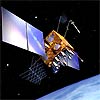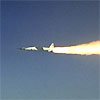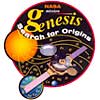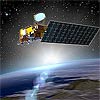|
Sunday:
April 11, 2004 | |
0457 GMT |
 |
Stars appear as grains of sand in nearby galaxy
What appear as individual grains of sand on a beach in this image obtained with NASA's Hubble Space Telescope are actually myriads of stars embedded deep in the heart of the nearby galaxy NGC 300.
 FULL STORY FULL STORY
 |  |

|
 |
|
Saturday:
April 10, 2004 | |
0222 GMT |
 |
Cassini watches as two storms merge on Saturn
Three months before Saturn arrival, the Cassini spacecraft caught two storms in the act of merging into one larger storm. This is only the second time this phenomenon has been observed on the ringed planet.
 FULL STORY FULL STORY
 |  |

|
 |
Controllers giving Spirit rover a software overhaul
Spirit has begun a four-sol stand-down while the rover receives a flight software update that should make its remaining martian days even safer and more productive, mission control reports.
 MISSION STATUS CENTER MISSION STATUS CENTER
 |  |

|
 |
Asteroid search taken to southern skies
The hunt for space rocks on a collision course with Earth has so far been pretty much limited to the Northern Hemisphere. But last week astronomers took the search for Earth-threatening asteroids
to southern skies.
 FULL STORY FULL STORY
 |  |

|
 |
NEWSWIRE Links to news across the internet
|
 |
NASA selects new class of astronauts -- (MSNBC) NASA has completed its selection of the next class of astronaut candidates, and is now telephoning the selectees to confirm their interest in moving to Houston, sources familiar with the selection process have told MSNBC.com.

Rutan group rockets toward X-Prize -- (Antelope Valley Press) Burt Rutan's Scaled Composites team rocketed one step closer to claiming the $10 million X-Prize award Thursday with a seemingly flawless test flight of the SpaceShipOne rocketship.
|
 |
|
Friday:
April 9, 2004 | |
0239 GMT |
 |
Mars rovers have missions extended through Sept.
NASA has approved an extended mission for the Mars Exploration Rovers, handing them up to five months of overtime assignments as they finish their three-month prime mission.
 FULL STORY FULL STORY
 |  |

|
 |

Additional coverage for subscribers:
 VIDEO:
THURSDAY'S NEWS CONFERENCE ON MISSION EXTENSION QT VIDEO:
THURSDAY'S NEWS CONFERENCE ON MISSION EXTENSION QT
 SUBSCRIBE NOW SUBSCRIBE NOW

|
Latest GPS satellite declared fully operational
A U.S. Air Force/Lockheed Martin team has completed on-orbit checkout of the upgraded Global Positioning System satellite launched successfully March 20 from Cape Canaveral. The spacecraft, designated GPS 2R-11, has been declared fully operational for navigation users around the globe.
 FULL STORY FULL STORY
 EARLIER LAUNCH COVERAGE EARLIER LAUNCH COVERAGE
 |  |

|
 |
IN OTHER NEWS Additional stories making news today
|
 |
NASA names exploration project directors -- NASA selected Garry Lyles as deputy director of Project Constellation and Charles Precourt as program director of the Crew Exploration Vehicle. Lyles is responsible for the development of all exploration transportation and support systems needed to achieve the Vision for Space Exploration. Precourt is responsible for developing the CEV -- NASA's first human exploratory spacecraft since Apollo.

New operations center heralds new era for GPS -- The Global Positioning System, the space technology that brought space-awareness to many civilian and military users alike, marked another historic milestone April 2 with the unveiling of a new GPS operations center.
|
 |
|
Thursday:
April 8, 2004 | |
0652 GMT |
 |
Launch of Einstein space mission delayed
A technical glitch has forced managers to postpone by two days the long-awaited launch of NASA's Gravity Probe-B spacecraft that will check key aspects of Einstein's general theory of relativity.
 FULL STORY FULL STORY
 |  |

|
 |
Successful X-43A mission proves scramjets work
NASA's successful X-43A hypersonic research aircraft flight resulted in a treasure trove of scramjet data. The initial data review confirmed high-fidelity flight data was obtained throughout the vehicle's boost, stage separation and descent to splash down.
 FULL STORY FULL STORY
 |  |

|
 |

Additional coverage for subscribers:
 VIDEO:
NEWLY-RELEASED VIDEO OF X-43A IN FREE FLIGHT QT VIDEO:
NEWLY-RELEASED VIDEO OF X-43A IN FREE FLIGHT QT
 VIDEO:
ONBOARD CAMERA FOOTAGE OF X-43A SEPARATION QT VIDEO:
ONBOARD CAMERA FOOTAGE OF X-43A SEPARATION QT
 SUBSCRIBE NOW SUBSCRIBE NOW

|
IN OTHER NEWS Additional stories making news today
|
 |
FAA issues license for historic launch -- The U.S. Department of Transportation announced it has issued the world's first license for a sub-orbital manned rocket flight. The license is to Scaled Composites of Mojave, Calif., headed by aviation record-holder Burt Rutan, for a sequence of sub-orbital flights spanning a one-year period.
|
 |
NEWSWIRE Links to news across the internet
|
 |
New Russian rocket Soyuz 2-1A to be first launched on October 15 -- (RIA Novosti) The first launch of the new carrier rocket Soyuz 2-1A, having digital control and the updated first and second stages, is scheduled for October 15, 2004 from the Plesetsk cosmodrome (the Arkhangelsk region, Russia's North-Western federal district), Alexander Chechin told RIA Novosti in an interview. He is the first deputy general designer of the Progress Central Specialised Design Office, based in Samara.

GAO says lax bookkeeping thwarts space agency audit -- (Houston Chronicle) Congress' investigative arm criticized NASA's accounting system again Tuesday, complaining that for the past four years, it has been impossible to verify spending on the international space station and space shuttle.

Canadian rocket man ready for lift off in Do-It-Yourself space race
-- (AFP) A Canadian crew has selected a launch date as it battles 27 other teams from around the world in a do-it-yourself race to blast a man into space, in a quest for a 10 million US dollar bounty designed to spur space tourism.
|
 |
|
Wednesday:
April 7, 2004 | |
0234 GMT |
 |
Milky Way past was more turbulent than known
A team of astronomers from Denmark, Switzerland and Sweden has achieved a major breakthrough in our understanding of the Milky Way, the galaxy in which we live. After more than 1,000 nights of observations spread over 15 years, they have determined the spatial motions of more than 14,000 solar-like stars residing in the neighborhood of the Sun.
 FULL STORY FULL STORY
 |  |

|
 |
Working to save Houston's Saturn V moon rocket
It could have launched Apollo 18, but it never got off the ground. Still, the Saturn V rocket on display at NASA's Johnson Space Center has long outlived its sisters that took men to the moon between 1969 and 1972.
 FULL STORY FULL STORY
 |  |

|
 |
IN OTHER NEWS Additional stories making news today
|
 |
PAS-6 communications satellite de-orbited -- PanAmSat announced that it has decided to de-orbit one of its in-orbit international spares, PAS-6, due to a failure in the satellite's power system. The Loral-built craft was launched in 1997.

Northrop Grumman tests new engine -- Northrop Grumman Corporation has developed and successfully tested a Reaction Control Subsystem engine for next-generation reusable space launch and transportation vehicles. The new engine burns nontoxic propellants, an achievement that enhances safety, reliability and affordability.
|
 |
|
Tuesday:
April 6, 2004 | |
0322 GMT |
 |
Saturn moon casts 'once-in-a-lifetime' shadow
A rare celestial event was captured by NASA's Chandra X-ray Observatory as Titan -- Saturn's largest moon and the only moon in the Solar System with a thick atmosphere -- crossed in front of the X-ray bright Crab Nebula. The X-ray shadow cast by Titan allowed astronomers to make the first X-ray measurement of the extent of its atmosphere.
 FULL STORY FULL STORY
 |  |

|
 |
Genesis locks the vault on solar wind collection
Since October 2001 NASA's Genesis spacecraft has exposed specially designed, collector arrays of sapphire, silicon, gold and diamond to the sun's solar wind. That collection of pristine particles of the sun came to an end last week when the spacecraft's collectors deactivated and stowed. The sample-return capsule lands on Earth later this year.
 FULL STORY FULL STORY
 |  |

|
 |
NASA's Aura satellite delivered to Vandenberg
NASA's Aura spacecraft, the latest in the Earth Observing System series, arrived at Vandenberg Air Force Base, Calif., to begin launch preparations. The 22.5-foot-tall, 3.25-ton satellite will serve as a space-based chemical laboratory, helping scientists to better understand the Earth's ozone, air quality and climate.
 FULL STORY FULL STORY
 |  |

|
 |
|
Monday:
April 5, 2004 | |
0454 GMT |
 |
Largest moon in the solar system imaged from Earth
Titan, the largest moon of Saturn was discovered by Dutch astronomer Christian Huygens in 1655 and certainly deserves its name. With a diameter of no less than 5,150 km, it is larger than Mercury and twice as large as Pluto. It is unique in having a hazy atmosphere of nitrogen, methane and oily hydrocarbons.
 FULL STORY FULL STORY
 |  |

|
 |
Celebrating 5 years of the Very Large Telescope
One of the world's most advanced telescope facilities, Very Large Telescope, situated in the Atacama Desert in Chile, celebrated its fifth birthday April 1. During its short history the telescope has captured some breathtaking images furthering our knowledge about the far reaches of our Universe.
 FULL STORY FULL STORY
 |  |

|
 |
IN OTHER NEWS Additional stories making news today
|
 |
Shuttle pump technology helps children's hearts -- The same technology that powers the Space Shuttle into orbit may now help children, thanks to a tiny heart pump recently approved for implantation in young, critically ill patients.
|
 |

